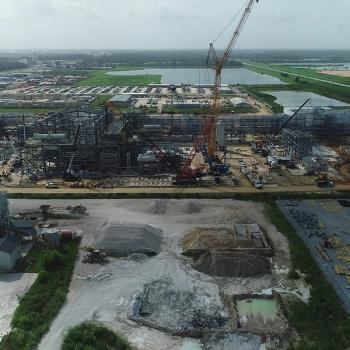
Impact of fuel composition on gas turbine performance
Below is an extract from a tutorial on gas turbine performance presented by Rainer Kurz of Solar Turbines and Klaus Brun of Southwest Research Institute at the 3rd Middle Eastern Turbomachinery Symposium in Qatar in February, 2015:
Fuel gas with a large amount of inert components (such as CO2 or N2) has a low Wobbe index, while substances with a large amount of heavier hydrocarbons have a high Wobbe index. Pipeline quality natural gas has a Wobbe index of about 1220.
In general, engines will provide slightly more power if the Wobbe Index is reduced. This is due to the fact that the amount of fuel mass flow increases for a given amount of fuel energy when the Wobbe index is reduced. This increases the mass flow though the turbine section, which increases the output of the turbine. This effect is to some degree counteracted by the fact that the compressor pressure ratio increases to push the additional flow through the flow restricted turbine. In order to do this, the compressor will absorb somewhat more power. The compressor will also operate closer to its stall margin.
The above is valid irrespective whether the engine is a two-shaft or single-shaft engine. The fuel gas pressure at skid edge has to be high enough to overcome all pressure losses in the fuel system and the combustor pressure, which is roughly equal to the compressor discharge pressure p2. The compressor discharge pressure at full load changes with the ambient temperature, and therefore, a fuel gas pressure that is too low for the engine to reach full load at low ambient temperature may be sufficient if the ambient temperature increases. If the fuel supply pressure is not sufficient, single and two-shaft engines show distinctly different behavior, namely: A two-shaft engine will run slower, such that the pressure in the combustor can be overcome by the fuel pressure.
If the driven equipment is a gas compressor (and the process gas can be used as fuel gas), 'bootstrapping' is often possible: The fuel gas is supplied from the gas compressor discharge side. If the initial fuel pressure is sufficient to start the engine and to operate the gas compressor, the gas compressor will increase the fuel gas pressure. Thus the engine can produce more power which in turn will allow the gas compressor to increase the fuel pressure even more, until the fuel gas pressure necessary for full load is available.
A single-shaft engine, which has to run at constant speed, will experience a severe reduction in possible firing temperature and significant loss in power output, unless it uses VIGVs. With VIGVs, the compressor exit pressure, and thus the combustor pressure can also be influenced by the position of the VIGVs, thus leading to less power loss (Figure 20). Without VIGVs, the only way to reduce PCD pressure is by moving the operating point of the compressor on its map. This can be done by reducing the back pressure from the turbine, which requires a reduction in volume flow. Since the speed is fixed, only a reduction in firing temperature -which reduces the volume flow through the gas generator if everything else remains unchanged- can achieve this. A reduced volume flow will reduce the pressure drop required for the gas generator turbine.
Industrial Gas Turbines allow operation with a wide variety of gaseous and liquid fuels. To determine the suitability for operation with a gas fuel system, various physical parameters of the proposed fuel need to be determined: Heating value, dew point, Joule-Thompson coefficient, Wobbe index, and others (Elliott et al., 2004). However, fuel borne contaminants can also cause engine degradation.
Special attention should be given to the problem of determining the dew point of the potential fuel gas at various pressure levels. In particular, the treatment of heavier hydrocarbons and water must be addressed. Since any fuel gas system causes pressure drops in the fuel gas, the temperature reduction due to the Joule-Thompson effect has to be considered and quantified (Kurz et al., 2004). Gas fuels for gas turbines are combustible gases or mixtures of combustible and inert gases with a variety of compositions covering a wide range of heating values and densities.
The combustible components can consist of methane and other low molecular weight hydrocarbons, hydrogen and carbon monoxide. The major inert components are nitrogen, carbon dioxide, and water vapor. It is generally accepted that this type of fuel has to be completely gaseous at the entry to the fuel gas system and at all points downstream to the fuel nozzle (ASME, 1992). Gaseous fuels can vary from poor quality wellhead gas to high quality consumer or “pipeline” gas. In many systems, the gas composition and quality may be subject to variations (Newbound et al., 2003).
Newsletter
Power your knowledge with the latest in turbine technology, engineering advances, and energy solutions—subscribe to Turbomachinery International today.




